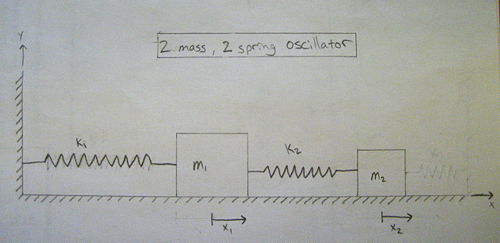|
|
| Line 205: |
Line 205: |
|
:<math>\dot{\bar{z}}=\bold{TAT^{-1}}\bar{z}</math> |
|
:<math>\dot{\bar{z}}=\bold{TAT^{-1}}\bar{z}</math> |
|
:<math>\dot{\bar{z}}=\bold{\hat{A}}\bar{z}</math> |
|
:<math>\dot{\bar{z}}=\bold{\hat{A}}\bar{z}</math> |
|
|
|
|
This new equation has the same form as |
|
| ⚫ |
:<math> \dot{\bar{x }}=\bold{ A}\bar{ x}</math> |
|
|
where |
|
where |
|
:<math>\bold{\hat{A}}=\bold{TAT^{-1}}</math> |
|
:<math>\bold{\hat{A}}=\bold{TAT^{-1}}</math> |
|
|
|
| ⚫ |
If we take the Laplace transform of this equation we can come up with the following |
|
| ⚫ |
:<math>\bar{z}=e^{\bold{\hat{A}}t}\bar{z}(0)</math> |
|
|
|
|
|
We know the values of T, A, and T^{-1}. If we calculate the value of <math>\bold{\hat{A}}</math> we will find that it is <math>\hat{\lambda}\bold{I}</math> |
|
|
:<math>\bold{\hat{A}}= |
|
:<math>\bold{\hat{A}}= |
|
\begin{bmatrix} |
|
\begin{bmatrix} |
| Line 233: |
Line 225: |
|
-0.2783i & 0.2783i & -0.5407i & 0.5407i \\ |
|
-0.2783i & 0.2783i & -0.5407i & 0.5407i \\ |
|
0.7409 & 0.7409 & 0.6421 & 0.6421 |
|
0.7409 & 0.7409 & 0.6421 & 0.6421 |
|
\end{bmatrix} |
|
\end{bmatrix}</math> |
|
|
:<math>= |
|
= |
|
|
\begin{bmatrix} |
|
\begin{bmatrix} |
|
2.6626i & 0 & 0 & 0 \\ |
|
2.6626i & 0 & 0 & 0 \\ |
| Line 241: |
Line 233: |
|
0 & 0 & 0 & 1.1877i |
|
0 & 0 & 0 & 1.1877i |
|
\end{bmatrix}</math> |
|
\end{bmatrix}</math> |
|
|
|
|
|
|
|
⚫ |
If we take the Laplace transform of the above equation we can come up with the following |
|
⚫ |
:<math>\bar{z}=e^{\bold{\hat{A}}t}\bar{z}(0)</math> |
|
|
where |
|
|
:<math>e^{\bold{\hat{A}}t}=\begin{bmatrix} |
|
|
e^{2.6626it} & 0 & 0 & 0 \\ |
|
|
0 & e^{-2.6626it} & 0 & 0 \\ |
|
|
0 & 0 & e^{1.1877it} & 0 \\ |
|
|
0 & 0 & 0 & e^{1.1877it} |
|
|
\end{bmatrix}</math> |
|
|
|
|
|
We then substitute this equation back into |
|
⚫ |
:<math>\bar{x}=\bold{ T^{-1}}\bar{ z}</math> |
|
|
and get |
|
|
:<math>\bar{x}=\bold{T^{-1}}e^{\bold{\hat{A}}t}\bar{z}(0)</math> |
Revision as of 15:49, 10 December 2009
Problem
In this problem we will explore the solution of a double spring/mass system under the assumption that the blocks are resting on a smooth surface. Here's a picture of what we are working with.
Equations of Equilibrium
Using F=ma we can then find our four equations of equilibrium.
- Equation 1

- Equation 2

- Equation 3

- Equation 4

Now we can put these four equations into the state space form.

Eigen Values
Once you have your equations of equilibrium in matrix form you can plug them into a calculator or a computer program that will give you the eigen values automatically. This saves you a lot of hand work. Here's what you should come up with for this particular problem given these initial conditions.
- Given




We now have

From this we get




Eigen Vectors
Using the equation above and the same given conditions we can plug everything to a calculator or computer program like MATLAB and get the eigen vectors which we will denote as  .
.




Solving
We can now plug these eigen vectors and eigen values into the standard equation

And our final answer is

Matrix Exponential
We already know what the matrix A is from our state space equation

And we know that the T-inverse matrix is
![{\displaystyle {\mathbf {T^{-1}}}=[{\bar {k_{1}}}|{\bar {k_{2}}}|{\bar {k_{3}}}|{\bar {k_{4}}}]\,}](https://wikimedia.org/api/rest_v1/media/math/render/svg/8c521818ac2f043cfb41f9ef03c202704a3b8f8b)

It then follows that matrix T is

Now we can use the equation for a transfer function to help us solve through the use of matrix exponentials.

This can be rearranged by multiplying T-inverse to the left side of the equations.

Now we can bring in the standard form of a state space equation

Combining the two equations we then get

Multiplying both sides of the equation on the left by T we get


where



If we take the Laplace transform of the above equation we can come up with the following

where

We then substitute this equation back into

and get
























![{\displaystyle {\mathbf {T^{-1}}}=[{\bar {k_{1}}}|{\bar {k_{2}}}|{\bar {k_{3}}}|{\bar {k_{4}}}]\,}](https://wikimedia.org/api/rest_v1/media/math/render/svg/8c521818ac2f043cfb41f9ef03c202704a3b8f8b)














